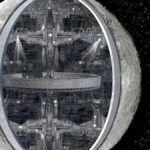That’s a hell of an article title, a hell of a concept. Is it really so wild? Let’s take a look…
First of all, we’ve seen over the past few centuries how humanity has been able to go from building tiny cabins that last only years, or decades at most, to skyscrapers a thousand times bigger, taller, and longer-lasting, as well as ships bigger than towns, airplanes that carry tanks, and Space stations that stay in orbit high outside the atmosphere and full of technological marvels that most can’t even conceive. We’ve come a long way. We’ve even built dams that change the ecosystems of entire regions, altered the direction of long rivers, and removed entire forests and mountains to make way for what we want instead. Wow.
Is it not so unreasonable, then, to project us continuing this trend? Will we not, presumably, in decades and centuries ahead, go on to build and change even bigger things? Things that make our current constructs look as tiny, puny, and brief as those first cabins –or even like the tipis and huts that came before them? Will we not build cargo ships and tankers in Space, and larger Space stations, and cities on other worlds? Will we not… eventually… remove and rebuild more than just rivers and mountains?
There are some satellite images now available which show moons with very curious features on them; features which span more than a river’s or mountain’s dimensions, and are much more than big impact craters. Take a look here and here, for example. Are these really natural formations? Could they have been made by people shaping more than just one mountain?
Now let’s say this is possible, and that it was done at least once or twice in the past for some reason. If you could rearrange mountains and mountain ridges, and then islands or even continents, …why not an entire world? …If you could build a ship bigger than a town, …what about out in Space where there is no limit to size at all? Could you build a ship big enough for many towns? How about entire civilizations? …Could you build a Space station as large as a small moon?
There are some who believe that the Moon; Earth’s own ‘satellite’, has no reason to be where it is, or how old its surface rocks indicate it is (far older than the Earth), or tidally-locked (always with the same side facing us), or resonating like it does when tested with explosives (it is said to ‘ring like a bell’, indicating it has more than just large caverns throughout its crust and core; it is hollow). There are some who claim that it is artificial, like a Dyson Sphere, and that it, being as old as it is, has functioned like a seashell borrowed and reused by numerous crabs. What is really the case?
The most interesting theory I’ve come across is that our moon is, in fact, artificial; man-made, and that where it was made, somehow and for whatever ancient reason, was inside the atmosphere of one of our gas giants; Jupiter. The story goes that it was built there and migrated here, perhaps among other places across Space, and was anchored in our orbit as a means of monitoring and regulating the new and bizarre lifeforms on this world. Millions of people live on and in it, and the towering ruins of those who used the Moon before them stand miles tall up from the lunar surface, some of them made entirely from some unknown form of super-strong glass. I know; a lot to take in. (See here.)
I neither believe nor disbelieve any of this. I am merely relaying an interesting theory and claim I heard. I’ll be going out there to this moon of ours one of these days, perhaps via Spaceport America, perhaps with other help, perhaps in a craft of my own. I suggest, if you feel so inclined, you make efforts toward the same; go out and see what is really out there in our solar system and beyond. See if you can find evidence of, or otherwise figure out, why so many of the land-forms on our world, and those of other worlds, seem so undeniably man-made. (Oh, and another hint and ‘bread crumb’ for you: the rings of Saturn look pretty artificial when you get up close and personal with them, too.)




